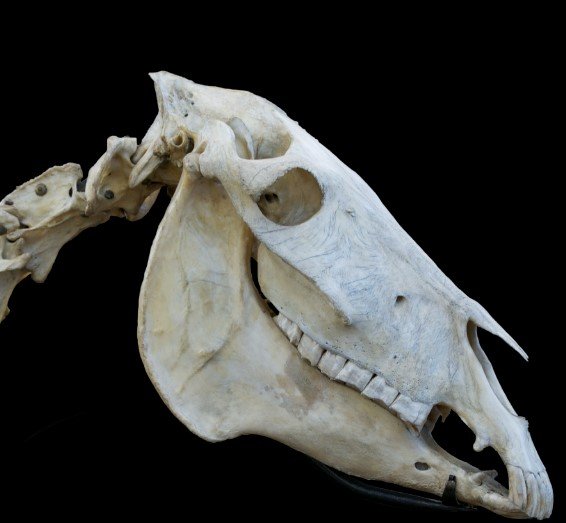A stash of donkey skeletons buried beneath ancient homes in central Israel is rewriting what we thought we knew about the Bronze Age—and it’s wilder than you’d guess.
Forget gold or scrolls. Archaeologists at Tell es-Safi/Gath have found something far stranger: imported Egyptian donkeys ritually sacrificed and buried under middle-class Canaanite houses nearly five millennia ago. Meanwhile, their local four-legged cousins? Butchered and eaten. A new study published in PLOS ONE is shaking up assumptions about trade, ritual, and even class identity in early Canaan.
Rituals, Relocation, and a Bite of Dinner
In the middle of what is now Israel, an unlikely group of immigrants met a holy end. Female donkeys, dragged hundreds of miles from Egypt around 2700 BCE, were laid to rest under homes at Gath—a Canaanite city best known in later centuries for producing Goliath, of biblical fame.
Meanwhile, in the very same neighborhood, another donkey—this one born and raised locally—was chopped into pieces and served for supper.
That strange duality prompted researchers to dig deeper. What they found offers one of the clearest windows yet into how ancient Canaanites viewed animals—not just as transport or meat, but as social symbols loaded with meaning.

The Science Hidden in Their Teeth
It might sound like CSI: Bronze Age, but it’s real science. Researchers used a combination of isotopic testing on the donkeys’ teeth, which can reveal where an animal grew up, what it ate, and even how its life changed over time.
The findings were clear-cut. The four female donkeys had distinct isotope signatures showing they grew up in Egypt. Over time, their tooth chemistry changed, suggesting they were gradually brought north—likely stopping at a few locations along the way—before reaching Tell es-Safi.
One of the Egyptian donkeys was sacrificed young. Another lived much longer, possibly even serving for years in Canaan before being buried beneath a home.
Then came the twist: another donkey skeleton from the site showed signs of butchering, not burial. And its isotope makeup was entirely local.
Donkeys as Status Symbols? You Bet
This wasn’t just about trade. It was about status, and maybe even spirituality. The imported Egyptian donkeys were buried intact, their skeletons carefully placed under homes during construction or renovation. That’s a serious commitment—burying an entire animal costs money, labor, and time.
And it wasn’t the elite doing this. These burials were found under ordinary homes.
“This wasn’t some palace. It wasn’t a king’s temple,” said study co-author Dr. Aren Maeir, the archaeologist leading the excavation. “These were middle-tier households.”
Which raises a fascinating question: why would middle-class families go through all that trouble?
Here’s what researchers think:
-
Imported donkeys, especially female ones, were prized for breeding.
-
Their Egyptian origins may have added spiritual value.
-
Sacrificing such valuable animals may have served to “anchor” a house spiritually—or socially.
It’s like blessing your new home, but with hooves and archaeology.
Who Was Trading What with Whom?
Historically, scholars didn’t think there was much contact between Egypt and inland Canaan during the Early Bronze Age III (roughly 2900–2600 BCE). Trade and diplomacy were believed to ramp up only much later.
But these donkeys say otherwise.
Maeir and colleagues argue that the animals are direct evidence of long-distance overland trade routes active centuries earlier than once believed. These weren’t pharaohs sending gifts—they were everyday people engaged in a broader commercial and cultural web.
A single donkey can cover long distances if you’re patient. And clearly, someone was.
The Meaning of a Dead Donkey
There’s no single takeaway here. If anything, the findings make early Canaanite life look more complex—and more connected—than anyone expected.
One paragraph in the study lays it out plainly: “The differential treatment of local and imported animals suggests a complex cultural valuation rooted in economic, spiritual, and possibly gender-based distinctions.”
The fact that the butchered donkey was likely male adds another layer. Female donkeys were more prized for reproduction. Males? Often considered expendable.
So even in donkey deaths, there’s a hierarchy.
A Glimpse of the Past That Feels Weirdly Familiar
What’s fascinating about all this isn’t just the distance the donkeys traveled. It’s how their journey tells us about humans.
These people weren’t royalty. They weren’t generals or prophets. But they still found ways to express belief, status, and identity—using what they had, which, apparently, included some very expensive asses.
“It’s incredible,” said lead author Haskel Greenfield. “These animals were part of family life, part of ritual life, and part of the economy. And now they’re helping us piece together a whole network of relationships that spanned hundreds of miles.”
In other words, bones talk.
Table: Summary of Donkey Findings at Tell es-Safi/Gath
| Donkey ID | Origin | Sex | Fate | Age at Death | Notes |
|---|---|---|---|---|---|
| A | Egypt | Female | Buried | Young | Possibly sacrificed shortly after arrival |
| B | Egypt | Female | Buried | Adult | Lived in Canaan for a time |
| C | Egypt | Female | Buried | Adult | Isotopic shift shows long-distance movement |
| D | Canaan | Male | Butchered | Adult | Consumed locally |
The study, published in PLOS ONE on July 9, 2025, is part of a broader excavation effort at Tell es-Safi that has been running for over two decades. But this time, it’s not pottery or buildings that’s stealing the spotlight—it’s donkeys, and the lives they led before becoming archaeological evidence.
Because sometimes, history isn’t written in stone. It’s hidden in teeth.
